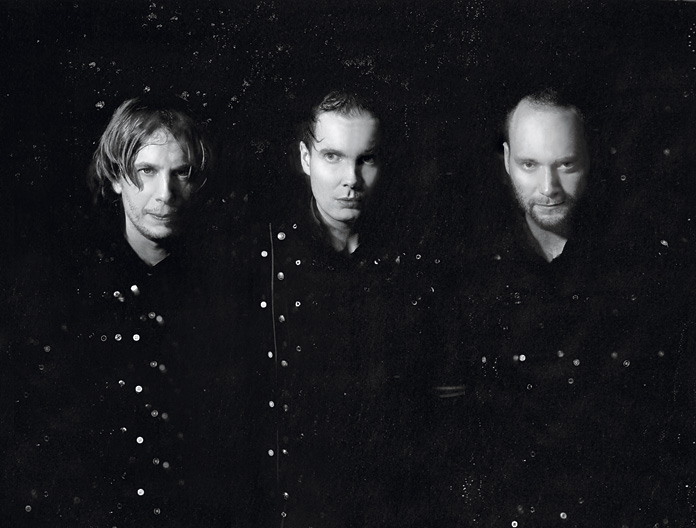
Sigur Rós
No Time for Myths
Sep 06, 2013
Sigur Rós
![]()
In a rock canon littered with fame junkies, opportunists, and self-promoters, the members of Sigur Rós stand out for never seeming similarly interested in building a mythology befitting a band of their stature. They are unambiguously understated personalities, as humble and unassuming as their music is expansive and grandiose, fronted by Jón “Jónsi” Þór Birgisson, a shy, soft-spoken man who declines most interview requests. They show little interest in their legacy, they generally shrug off questions about their personal lives or the interpersonal relationships within the band, and they rarely have much revealing to say about how their albums are made. In fact, if they are to be believed, they approach their creative process with little or no premeditation, instead entering the studio, picking up instruments, hitting “record,” and seeing where their intuition leads them. After nearly 20 years of making music, the process obviously works for them. But what makes for good music sometimes makes for weak mythology.
Unfortunately, the mythology that sprung up around 2012’s Valtari depicted a band that seemed dangerously close to running out of momentum. That album, a series of new songs and unfinished song sketches that dated as far back as 2005, had been a creative struggle and (for them) a critical misfire, adding fuel to speculation that the band should have taken a longer break after ending a decade of relentless touring and album-making in 2010. Adding fuel to that speculation, longtime member and multi-instrumentalist Kjartan Sveinsson left the band before they began another round of touring, leaving them a three-piece. Great bands have survived far worse records than Valtari, but, as if trying to get the taste of that unsatisfying experience out of their mouths, Birgisson, drummer Orri Páll Dýrason, and bassist Georg Hólm jumped into working on Valtari‘s follow-up before it was even released. Stripped down to guitar, bass, and drums for the first time since the band’s earliest days, Kveikur was born.
“It was so much fun making this record,” Hólm says with a tone that seems to imply that their last one was less than enjoyable. “We were all pushing each other out of our comfort zones and being noisy, being experimental with our instruments. The way this album was written is very much like that. It was just the three of us playing and pushing each other, like, ‘You can do better than that. Do something weird!’ Just basically having fun.”
“Fun” likely isn’t among the first words that come to mind when thinking of the majestic sprawl of Sigur Rós’ music, but it is surprisingly accurate in the case of Kveikur. Hólm explains that the title of the album came from the Icelandic word for a candle wick, but he suggests that the alternate meaning of a fuse in a stick of dynamite is more appropriate. If so, opening track “Brennisteinn” captures the moment of the album’s detonation. With an avalanche of ominously rumbling bass distortion that is quickly overwhelmed by thundering drums and chaotically clanging cymbals, it is doubtlessly the ugliest, most menacing song the band has ever recorded, with even Birgisson’s angelic vocals rendered a bit sour in the clatter. Hearing them willfully deface their sound is nothing less than thrilling.
The songs that follow aren’t nearly so dark, but they are just as immediate, their usual glacial drones now overlaid with creaking electronic fissures and clattering percussion. Where their arrangements occasionally were bogged down in atmospherics, here their melodies take a more direct flight path-the soaring choruses of “Ísjaki,” in particular, standing out among the most perfect pop hooks they’ve ever crafted. Whether or not these streamlining shifts are due to the band being refocused as a three-piece, Hólm won’t say, but Sigur Rós has never made an album with so many human fingerprints smudging up their usually pristine sound.
“I think when we recorded it and we listened back to the recordings-before we started layering things on top of it-we all thought, ‘Wow, this actually sounds really good,’” Hólm explains. “This was the first time that we’ve recorded something and we didn’t feel like, ‘Oh, we’ll have to fix this in the mix or in the mastering.’ I think it was the first time ever that we recorded something and we thought, ‘Wow, we could just release this as it is. We don’t even have to work on it.’ Though we obviously did. But it happened quite quickly.”
That spontaneity ends up being the defining characteristic of Kveikur, and while they’ve made more groundbreaking or idiosyncratic records, this is the one they needed to make to inject some unpredictability into a trajectory that a year ago appeared close to entering a decline phase. Though Hólm suggests that they have little interest in how their music is perceived by fans or critics, his tone changes when the topic shifts to the band’s recent addition to the select group of acts that have had their yellow-skinned likenesses appear on The Simpsons. Chosen by longtime fan and Simpsons creator Matt Groening to provide incidental music and a rendition of the show’s theme for an episode set in Iceland, the band ended up using their backstage time on tour gathered around a laptop, trying to craft their contributions for the season finale of the show’s 24th season. Though their mythology allows little room for boasting, in this one case they are willing to make an exception.
“Being on The Simpsons, we said, ‘Now we’ve made it,’” Hólm says with satisfaction. “We can retire happy.”
[This article first appeared in Under the Radar’s June/July 2013 print issue.]
Most Recent
- Premiere: Cameron Leahy Shares New Single “From The Infinite” (News) — Cameron Leahy
- Angel Olsen Announces Intimate Solo U.S. Tour Dates for This Fall (News) — Angel Olsen
- of Montreal Shares Video for New Song “Rude Girl on Rotation” (News) — of Montreal
- Belle and Sebastian Share New Song “What Happened to You, Son?” (News) — Belle and Sebastian
- Cassandra Jenkins Announces New Album, Shares Video for New Song “Only One” (News) — Cassandra Jenkins


Comments
Submit your comment
September 6th 2013
6:58pm
for my (hard-earned) money, the lads have never quite again scaled the heights trekked on ( ) & takk….which doesn’t make them bad people. or a bad band. they’re a GREAT band. imponderably adrift at times. like pynchon on ludes. s’okay…i like my masterpieces inscrutably thick. i just miss the old look of ‘em….the old sound…..ye olde daze.